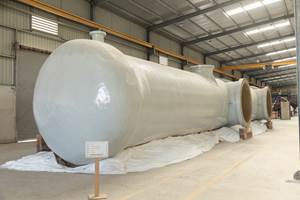From the Publisher
Introducing composites into the infrastructure and construction markets is a process fraught with complexity. Although they are capable of high performance, composites are usually adopted into new markets on the strength of their other benefits, such as corrosion resistance and weight savings. In the infrastructure
Introducing composites into the infrastructure and construction markets is a process fraught with complexity. Although they are capable of high performance, composites are usually adopted into new markets on the strength of their other benefits, such as corrosion resistance and weight savings. In the infrastructure arena, however, components almost always require truly critical structural performance as well. Delivering high-level performance requires the selection of not only strong, reliable, yet affordable materials but also a design optimized for both the part requirements and the chosen manufacturing method. If all goes well, you end up with a great part - one that will do the job and can be priced to compete. Then you get to prove it to your potential customers. Despite these challenges, composites already have made significant inroads into infrastructure. Today, prices are rising for traditional materials, and there is an ever-growing number of engineers that now recognize the unique characteristics composites can bring to a project. The greatest challenge going forward - and the key to future growth - is developing products that can meet all applicable standards.
Not only does every global geographical region and country have its own set of procedures, test methods and codes for civil structure, nearly every state and municipality does as well. Great strides are being made to standardize these requirements - there are entire governmental agencies and associations working on these issues. CT tries to keep up with new code standardization and, as part of that effort, we are happy to announce a cooperative effort with Larry Bank, author of the new book, Composites for Construction - Structural Design with FRP Materials. In every issue this year, he will write a column, partially excerpted from his book, that discusses code-based design procedures for a specific type of FRP structure - procedures that will enable engineers to ensure, at design inception, that a product will meet requirements. Bank begins this issue with composite rebar for concrete reinforcement (see “Related Content,” at left). We trust this editorial feature will be of practical use to you, our readers. We'd like to hear your opinion on it as well as anything you'd like to add.
The new year brings other good tidings, as well: After a two-year search, Composites Technology has found a new home. This month, CT becomes part of Ohio-based Gardner Publications Inc. As many of you know, our small media company of around 15 dedicated people has been devoted to providing timely, useful information about the design and manufacture of composite materials. We were around during the boom times in the 1990s and are proud to say we weathered, along with the rest of the composites industry, the tough economic times in 2002 and 2003 - founding Compositesworld.com, the industry's leading Web site, during that time.
But we have felt for some time that we could benefit greatly from an association with an anchor company that might provide the stability and resources needed to further enhance our services for our customers - readers and advertisers alike. Toward that end, Gardner, our new owner, is an ideal partner. Established in 1928 with the still-thriving trade magazine Modern Machine Shop, Gardner's current publications all focus, like CT, on the world of manufacturing. Gardner's is a multimedia business that delivers information about manufacturing technologies, suppliers and products to its readers by a variety of sophisticated means. As we go forward, that will be important to us.
While we'll be working, in the background, to integrate our products into Gardner's established systems - which we assume will be a seamless transition - there won't be any noticeable changes to the magazines, e-newsletter or Web site in the short term. In the long term? The only change you'll see will be change for the better.
We wish you and your company as great a year as we anticipate at Gardner.
Related Content
EuCIA launches the European Rebar Council to drive FRP rebar market opportunity
Composite rebar promotion and adoption goals form the backbone of this sectorial alliance, with four working groups to drive the Council’s activities.
Read MoreR-Tech Materials offers accredited composite rebar testing
The independent U.K. lab has has developed a comprehensive suite of materials testing capabilities tailored to the growing demands of the construction sector.
Read MoreRock Fiber Inc., ReforceTech form ReforceTech Americas
Joint venture entity will drive the availability and applicability of fiber reinforcement in construction to clients worldwide.
Read MoreIndustrial equipment manufacturer expands global footprint, reaches into new markets
India-based CW Top Shops honoree EPP Composites reflects on a recently successful vertical filament winding application and new pultruded FRP rebar capabilities, as well as future opportunities.
Read MoreRead Next
Cutting 100 pounds, certification time for the X-59 nose cone
Swift Engineering used HyperX software to remove 100 pounds from 38-foot graphite/epoxy cored nose cone for X-59 supersonic aircraft.
Read MoreCeramic matrix composites: Faster, cheaper, higher temperature
New players proliferate, increasing CMC materials and manufacturing capacity, novel processes and automation to meet demand for higher part volumes and performance.
Read MoreNext-gen fan blades: Hybrid twin RTM, printed sensors, laser shock disassembly
MORPHO project demonstrates blade with 20% faster RTM cure cycle, uses AI-based monitoring for improved maintenance/life cycle management and proves laser shock disassembly for recycling.
Read More








